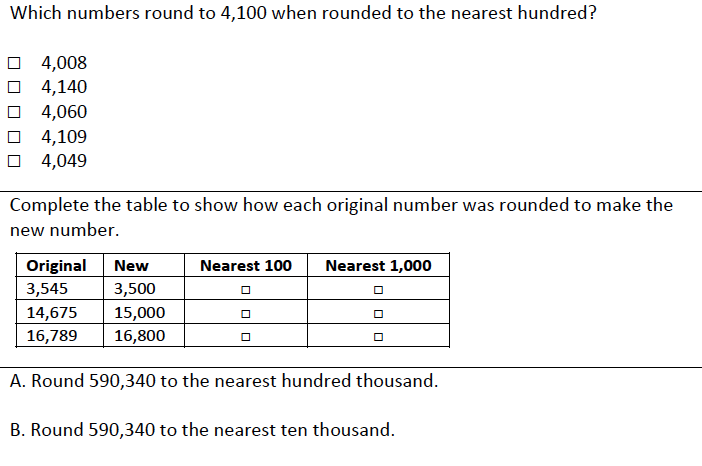Use place value understanding to round multi-digit whole numbers to any place.
[divider] [/divider] Students are able to…
- Determine situations in which rounding is appropriate and decide which place value to round to.
- Identify which benchmark numbers a specific number would be between on a number line based on the place value the number will be rounded to.
- Use models and strategies for rounding and determining reasonableness.
[divider] [/divider] Students are able to…because teachers:
- Promote the discussion of using rounding to determine reasonableness of answers.
- Use a variety of activities where students use multiple strategies and round to different place values.
- Ask students to explain their strategies and help students make generalizations about rounding.
[divider] [/divider] Questions to ask students:
- What is rounding and why is rounding important?
- Sample answer that indicates understanding: We round to get an estimate and see if an answer is reasonable.
- How could you use the tool of a number line to help you round?
- Sample answer that indicates understanding: A number line can help you visualize the range, middle number and location of the number to determine what I would round to.
- What is 2,374 rounded to the nearest hundred?
- Sample answer that indicates understanding: 2,374 rounded to the nearest hundred… the range is 2,300 to 2,400 and 2,374 is closer to 2,400 so that’s what I’d round to.
- What is 2,374 rounded to the nearest ten?
- Sample answer that indicates understanding: 2,374 rounded to the nearest ten… the range is 2,370 to 2,380 and 2,374 is closer to 2,370 so that’s what I’d round to.
- Ask students if they can round larger numbers (i.e. 384,810) without using a number line, and explain using place value how they knew the estimate.
- Sample answer that indicates understanding: If I rounded 384,810 to the nearest thousand, it would be 385,000 because I know that the 800 means the number is closer to the next thousand, which would be 5,000.
- Sample answer that indicates an incomplete understanding or a misconception: If I round 384,810 the 8 tells me to go up so I change 4 to a 5 and all other digits go to zero so its 385,000.
[divider] [/divider] FSA Notes
Cognitive Complexity Level: 1 – Recall
Achievement Level Descriptors:
2- uses place value understanding to round multi-digit whole numbers to any place within 1,000
3- uses place value understanding to round multi-digit whole numbers to any place within 1,000,000
4- uses place value understanding to round whole numbers up to any place where the digit to the left is also affected (e.g., round 199 to the nearest ten)
5- determines a number that falls between two numbers of different place values
Assessment Limits:
Given values and item solutions may only be whole numbers between 1,000 and 1,000,000.
[divider] [/divider] Additional Resources:
Additional in depth content knowledge
Blog Post: Round and Round we go…Where will we stop…At Rounding?
Video: Round numbers to a specified place on a number line
[divider] [/divider] Sample Formative Assessment Tasks:
Resources/Tasks to Help Your Child at Home:
Roll, spin or create a 6 digit number with a deck of cards. Choose a place to have your child round to and encourage them to draw a number line to prove how they rounded the original number. It’s also helpful to break down the steps to creating a number line to round by first choosing the range, then the middle number, the location of the number and then what they would round to based on the location.
Khan Academy: Rounding Whole Numbers to Nearest Ten https://goo.gl/stN46j
Khan Academy: Rounding Whole Number to Nearest Hundred https://goo.gl/d6sdj5
Khan Academy: Rounding Whole Numbers to Nearest Thousand https://goo.gl/ThJoX3
